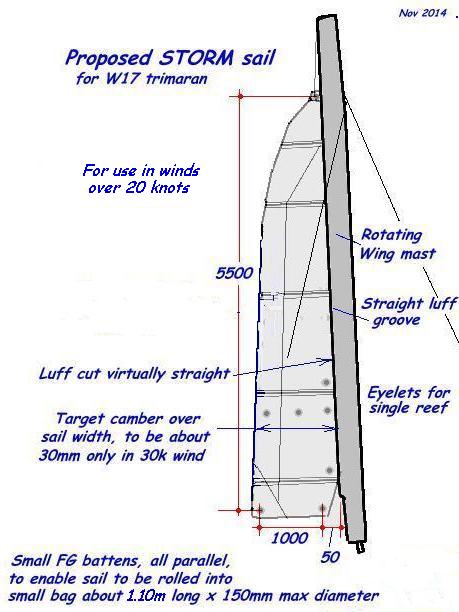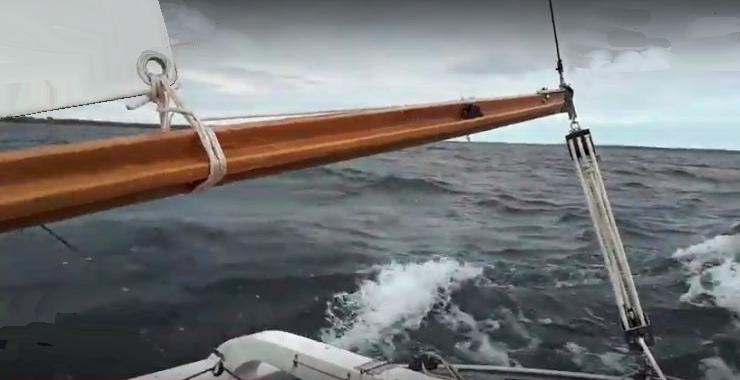


Sailing with a Storm Sail
Storm Sail Testing and Use
After proving that the W17 hulls and folding system could take some pretty rough conditions without problem, I decided that carrying a storm mainsail that could be rolled up in a small bag, would be a great way to get home should conditions turn really ugly. So I drew up a fairly high-aspect ratio sail that measured barely 1 meter along the foot. It ended up being less than 4m2 (43 sqft) in area, but I was not looking for speed. What I hoped for however, was a sail that would work efficiently behind the rotating wing mast, to still give excellent performance upwind. I had the sail cut very flat and fitted with 5 full-length parallel battens that permitted it to be rolled up to about 6” (150mm) diameter. As such, this sail will easily stow in the forward compartment under the shelf, as does the similar-sized tent package. A short tack pennant permits one to easily adjust the boom height.
The result was highly successful and with only 90 sqft feet of sail in total, the boat was still nicely balanced and on trials we achieved a surprisingly steady 8kts upwind and hit 11kts on a broad reach. For a couple of days before we headed out, winds had been blowing 25 to 35 knots, so the seas were well established and as is typical of large lake conditions, they were also close and steep. The local meteorological office was still reporting seas of 3 to 5ft in height, but the wind had started to moderate a little by the time we headed out and was down in the 20-25kt range, though some waves were certainly still a good meter in height. Video of such conditions always tends to make things look calmer than they were, but here’s what my crew managed to capture with his handheld smartphone. I really hope that some of you who watch this are hardened dinghy cruisers, just as I was as a young man cruising in the UK Solent. I still remember as you will, battling wind and waves while constantly being thrown off course by unpredictable crests, and struggling to make even 3 knots upwind while constantly bailing to keep the boat from becoming swamped. I see many such videos taken on board traditional dinghies but its now getting hard for me to watch. This video excursion below, with the high aspect storm sail on a W17, is such a totally different experience! As the three hulls of a W17 average 16 foot in length, compare this ride and ability with one of the most proven 16ft cruising dinghies out there ... the Wayfarer ... and I think you will discover there's a whole new way to cruise, even into your 80's!. The W17 is totally self-bailing and goes upwind in this stuff at 7-8 kts !!
Hope you enjoy it. (If full screen viewing proves too jerky, just view in basic size).
If anyone is interested in a W17 storm sail like this, I can get you the sail, battens, insignia and a sail bag for about US$300 (2017).
 We thought it was a lot of fun and the boat felt safe and secure the whole time, even if the short steep waves can throw you around a bit. As you can see in the video, any slamming was rare and even then it was gentle, with the leeward ama just slicing through waves like butter.
We thought it was a lot of fun and the boat felt safe and secure the whole time, even if the short steep waves can throw you around a bit. As you can see in the video, any slamming was rare and even then it was gentle, with the leeward ama just slicing through waves like butter.
I always check that the hinges have no slack before heading out in rough conditions and if need be, one can just gently tap in some thin cedar wedges. These swell up as they get wet and from my experience, stay nicely in place all season.
All you additionally need for conditions like this, is some good clothing. Apart from the essential life-vest, a ‘dry suit top’ or semi-dry paddling jacket plus a wind-resistant hat (or wool ‘tuque’) with good booties, work just fine for me. While we were out, both water and air were around 57F ... so starting to get pretty cool.
IN EXTREME CONDITIONS
If it’s really howling, say over 30kts, it’s still possible to ‘get home’ unless wave conditions in your particular area are really extreme. First, you need to accept that ‘SLOWER is safer’. Sailboats need time to negotiate steep waves. Too much sail will force you through them unnaturally fast, with the bow unable to respond in time .. and if you’re surfing too fast downwind, there’s always the risk of stuffing the bow into the wave in front and pitchpoling ANY multihull. With large boats, the time-honored way is to reduce sail and tow something resistant behind to control the speed. An old car tire with a little chain was one classic solution, but far too much for a small boat like the W17. But one could still drag a small 8” trailer tire … or if I were stuck, a plastic gall of water tied securely to a spare lifejacket (to prevent it sinking too far down) could work, all payed out on at least 50ft of line. But as you’d also want to reduce sail, you’ll need to furl the jib. While the boat sails fine with only the storm main, tacking is tricky in steep waves, as you really need a little sail up front to pull the head of the boat on to the new tack.
 Unfortunately, the furling we use on these foresails is NOT designed for reefing so if you tried to use the sail half-unrolled, the jib sheet load would pull the sail unnaturally around the wire luff and damage the sail or even the wire. But one can try this.
Unfortunately, the furling we use on these foresails is NOT designed for reefing so if you tried to use the sail half-unrolled, the jib sheet load would pull the sail unnaturally around the wire luff and damage the sail or even the wire. But one can try this.
First furl up the jib as firm and tight as practical. Then add a tie (ideally a cloth strip) securely around the rolled jib, as high as you can comfortably reach from the foredeck – say 6ft (1.83m). Now unroll the jib until the sail is nearly at the tie and then add a second tie near the base of the sail - just below where the foot is leaving the rolled jib. Make sure the furling line is well cleated. To prevent these ties from damaging the jib leech, do not sheet-in this small triangle of sail tightly, but this little ‘handkerchief’ of sail (about 4 sq.ft) will still be enough to help you complete a tack in rough conditions. If you are caught out with too much sail and then need to furl the jib to this reduced size, a regular furling gear can really struggle to do this. But check out this article on Survival Sailing for a tip that may help you.
The other way to ‘change tack’ would be to simply gybe around. This is easy with a trimaran and particularly with the storm sail, quite safe and efficient to do at speed, as there is then less wind in the sail. Keep your weight aft during such a maneuver. But of course, if you’re trying to get upwind, you will lose a few boat lengths with a gybe. Stay within your experience … and have fun!
See also: "When to Reef", for surprising performance figures with this sail.
.
UPDATE: February 2020
WARNING NOTE: When sailing with the Stormsail, the load on the boom changes, requiring some operational adjustment and care. Normally, with the mainsail leech-load and the mainsheet being almost vertically under it, the only boom load is a slight compression in the boom, but when you set the Storm mainsail, that vertical leech-load is now applied only about 40% back from the mast. Although the load is barely half the normal, your boom-end mainsheet has a long leverage-arm and it will be very easy to accidentally over-sheet and overload the boom in bending. In fact, you will have enough power there to potentially even break the boom! 
So just be aware of the risk and keep an eye on the boom deflection when sheeting in firmly. A 20mm bend is probably the maximum I'd recommend for the standard W17 boom, though if you really think you want more leech load, you could strengthen the boom for 600mm both fore and aft of where the stormsail clew is attached by adding UNI-CF along the four edges of the '+' sectioned boom, though if your boom is of mahogany (as the Manual suggests), it can take the load IF the mainsheet is not abusively over-tightened. The twin-ply stormsail leech of a W17 Stormsail does not need excessive loading to remain fairly straight, so just keep an eye on your boom bend and ease off if needed.
____________________________________________________________________________________________
mjw © 2017-2020
"New articles, comments and references will be added periodically as new questions are answered and other info comes in relative to this subject, so you're invited to revisit and participate." —webmaster